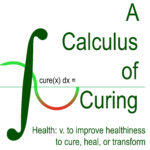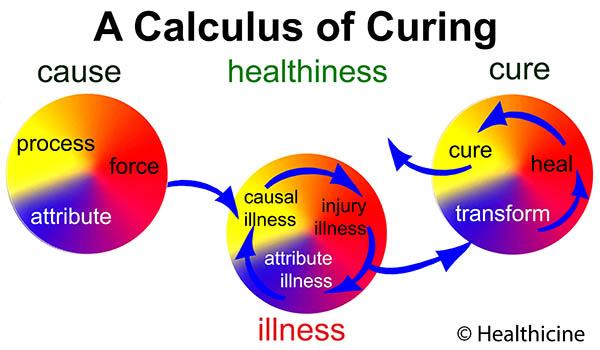 Conventional medicine has a huge problem with cure. It’s a technical problem: “cured” is not defined for any non communicable disease. Because cured is not defined, no non communicable disease can be cured and proven to be cured.
Conventional medicine has a huge problem with cure. It’s a technical problem: “cured” is not defined for any non communicable disease. Because cured is not defined, no non communicable disease can be cured and proven to be cured.
The World Health Organization’s International Classification of Diseases describes three types of illnesses:
- Communicable diseases (caused by a parasite),
- Injuries (the cause is gone)
- and non communicable diseases
Communicable diseases are cured by addressing the cause, generally by killing or removing the parasite. Injuries are cured by healing, although the word ‘cured’ is seldom used for injuries.
Non communicable diseases are never cured. NEVER. Of course there are claims of cures, but, cured is not defined, cannot be tested, cannot be proven. Cures are ignored.
Why is this so? Non communicable diseases are caused by an absence of healthiness, a hole in health. An absence of healthiness cannot be filled with a medicine. Thus, medicines cannot cure non communicable disease – therefore, non communicable diseases cannot be cured by medicines, therefore: non communicable diseases cannot be cured.
You might think medical researchers are “searching for cures”. But no. Current medical research, current clinical studies, function entirely without a definition of cured. Researchers develop “treatments” (not cures) and measure how those treatments “work” (not cure) vs other treatments or placebos. Journalists often report that research is “moving us closer to a cure” without any concept of a cure. Frankly, it’s ridiculous, as if we claimed that our random walks are moving us closer to “XYZZY” – an undefined location.
Cured is not difficult to define. We can use the same definition used for communicable diseases:
an illness is cured when the cause has been successfully addressed
We might add a few additional conditions – these also apply to communicable diseases:
- an illness is cured when the signs and symptoms have faded and gone (there may be permanent consequences)
- an illness is cured when no more medicines are required for signs and symptoms
- if the cause occurs again, a new illness occurs (not a remission)
Maybe some of you noticed that I switched from “disease” to “illness”. Why? Conventional medicine has another cure flaw. Disease is not defined. There are lists of diseases. The World Health Organization list of diseases contains over 70,000 disease codes. But many of them are clearly not diseases, and there is no scientific or medical definition of a disease other than “it’s on the list“. Medical insurance often refuses to pay because “it’s not on the list“. The WHO list is primarily a list used for billing, not for science. When we look closer, it gets worse, not better. Many diseases are very, very fuzzy. The DSM/5, the Diagnostic and Statistical Manual of Mental Disorders (not diseases) defines depression as a “symptom domain”. Often the word disease seems to be deliberately avoided, due to definition issues.
So, I use the word illness. Of course illness is not defined either. We need a better word, but none exists. We need a word for “curable illness”. When I use the word illness, I am referring to a “curable illness“. What is the point of trying to cure an incurable illness?
Thus, the title changes slightly, to “How to Cure any Curable Illness”. But I suspect that title would seem a bit redundant. It is not redundant, because most curable illnesses cannot be cured by today’s conventional medicine.
How to Cure any Curable Illness: Address the cause and the consequences.
If the cause is a parasite, then address the parasite cause. If the cause is gone – address the signs and symptoms, and aid healing. If the cause is something else, the cause is a lack of healthiness. Address the lack of healthiness.
How can we learn to understand CURED for non communicable illnesses? We begin with very simple cases, elements of illness, having a single cause. Once we learn to cure elementary illnesses, we build our knowledge and understanding of cure, cures, curing and cured to address more complex cases.
Let’s begin with a trivial example (in theory): SCURVY
Scurvy is caused, in theory, by a lack of Vitamin C. The treatment (not cure) recommended for scurvy, by all major medical reference texts, is supplemental Vitamin C. But this treatment cannot cure. Why not?
Supplemental Vitamin C satisfies the first condition of cured, and fails the next, the medicine must be continued forever. If the patient has scurvy, and it is treated with supplemental Vitamin C, the patient must take supplemental Vitamin C for the rest of their lives (unless their diet changes). Supplemental Vitamin C is not the cure, because a lack of supplemental Vitamin C was not the cause. The cure for scurvy is to address the cause, to address the dietary cause. The cure for scurvy is health, a healthy diet.
But a healthy diet is not a medicine. No medicine can cure scurvy, so cured is not defined medically for scurvy. As a result, medical reference texts offer “treatments” for scurvy, but do not use the word “cure”.
We can create thousands of more examples that illustrate the concepts of curing non communicable diseases, but this article would be thousands of pages long. What would we learn?
We would learn there are three basic types of causes of illness, which lead to three types of illness (which do not match the WHO categories) and three basic types of cures. This is a summary taken from the book: A Calculus of Curing, and illustrated in this diagram:
An element of illness can have one of three basic causes: a process, a force, or an attribute. We might use different words, as basic as a verb cause, a noun cause, and the action or force of a verb (a process) acting on a noun (a thing).
A process cause is a cause that is part of a process, like nutrition. Eating healthy foods is a healthy life process. Eating unhealthy foods, or not eating healthy foods can cause illness – like obesity or scurvy. A illness caused by a process is a “causal illness”, which is cured by addressing the “causal process”.
An attribute cause is a thing that causes illness. It might be a physical thing, or weakness, or excess of strength of a physical thing, or it might be a non-physical thing. Hernias are physical attributes that cause illness. With attribute illnesses, the cause is often physical, so the cause and the illness often have the same name. Attribute causes are cured by addressing the cause, but because the cause is a “thing”, we cannot address the process, we cannot change the process, we must change the thing. An illness caused by an attribute is called an attribute illness, and attribute illness elements are cured by transformation of the cause. A hernia is cured by surgical repair.
A force cause exists when a process interacts with a thing. resulting in an injury. An injury might be caused by a sword, or a fall. An injury might also be caused by a causal illness, or by an attribute illness.
When an illness element is an injury, the cause is gone. Injuries are cured by healing. If the cause is still present, that is another illness element, which must be addressed independently.
That’s it. The basics of curing, in one simple diagram. Of course after that, it gets complicated. There are three basic complications.
- Causes of illness can be in the body, the mind, the spirits, the communities, or the environment. Curing, addressing the cause, requires a correct identification of the cause of the illness. If the identified cause is wrong, the illness will not be cured, or the cure will not stick, as with the example of scurvy and supplemental Vitamin C.
- Elementary illnesses combine to create complex illnesses and compound illnesses. Complex illnesses have a single cause, but multiple illness consequences, requiring multiple cures. The common cold is cured by health, but while present it might cause a nosebleed, which must be cured by healing. Compound illnesses have multiple causes – and require multiple cures. Many diseases are compound illnesses, which appear to be incurable because no single action can cure.
- Any illness element can be chronic, when the cause is chronic. Scurvy only occurs after a long period of deficiency. Athletes and office workers often experience repetitive stress injuries. Attribute illnesses are chronic by nature, because the cause is a thing that exists over time. A chronic illness can only be cured by addressing the chronic nature of the cause.
Every curable illness can be cured. If it’s not a curable illness, shouldn’t we call it something else? A disability, a handicap, a natural feature?
Every illness can be cured – A Calculus of Curing
This post is based on the concepts of the newly published book: A Calculus of Curing.
to your health, tracy
Founder: Healthicine
Author: A Calculus of Curing



